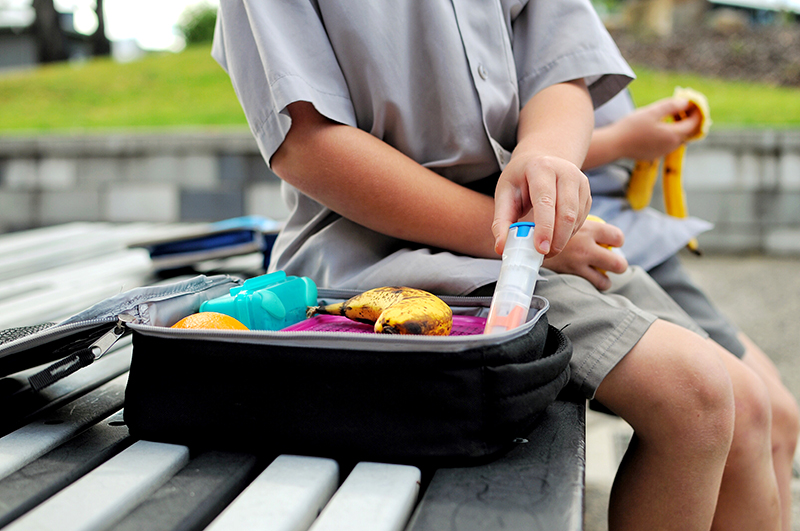Food allergy affects over 600,000 children in Canada — about 3 students in a class of 30. Despite the prevalence of this serious medical condition, which can trigger anaphylaxis — a potentially life-threatening allergic reaction — significant gaps in understanding and management persist, often leading to social exclusion and anxiety among children with food allergy.
Preventing reactions and staying safe is a shared responsibility. As principals and educators, you have a powerful role in building safe, inclusive environments that protect students with food allergy and empower the entire school community.
In this article, Food Allergy Canada reviews strategies within a comprehensive anaphylaxis management policy, providing educators with actionable approaches to safeguard students and promote understanding.
1. Recognizing At-Risk Students: Identification & Emergency Planning
At the heart of effective allergy management is knowing exactly who is at risk. Food Allergy Canada recommends creating an Anaphylaxis Emergency Plan for each student with known allergies, detailing their specific triggers, how to recognize symptoms, and clear instructions for emergency response. In many provinces and territories, such plans are mandatory.
2. Training & Education: Empowering Staff and Students
Knowledge-based prevention is a cornerstone. Food Allergy Canada offers AllergyAware.ca, a free, interactive, and mobile-friendly online course—typically around 30 minutes—that trains staff on recognizing anaphylaxis, reducing risks, and emergency response, ending in a personal certificate of completion. Similar training is available for childcare professionals. This resource fulfills knowledge gaps and ensures consistent training across the country. Recent research published in Allergy, Asthma & Clinical Immunology confirmed that this course is not only scalable and accessible, but that it improves confidence in anaphylaxis management among school staff.
Empowering students is equally crucial. Food Allergy Canada offers the free All About Food Allergy student program—curriculum-linked, medically reviewed, and tailored for elementary/middle school students—offering lesson plans, presentations, games, and group challenges that promote inclusion and peer support. These educational tools increase awareness, help reduce bullying, and foster empathy—helping students become informed allies.
Schools can also benefit from resources designed specifically for foodservice teams. Food Allergy Canada’s Think Food Allergy initiative offers practical tools to help food handlers understand the seriousness of food allergy and reduce risks in cafeterias, and other school meal programs. These resources reinforce allergy awareness, safe food preparation, cleaning, and serving practices. By equipping foodservice staff, schools can strengthen their allergy management approach and provide safer environments.
3. Prevention First: Avoidance of allergic reactions
Reducing exposure to allergens is critical. Schools must implement:
- Adult supervision during all eating times, with supervisors who are aware of which students have food allergies, what their specific allergens are, and how to respond in the event of a reaction.
- Cleaning protocols in classrooms, cafeterias, and shared areas to minimize allergen exposure.
- Hand-washing routines before and after every meal, to prevent cross-contamination.
- A “no food sharing” policy in all classes to reduce accidental exposure.
- Specific protocol for eating locations for when food is consumed, depending on the age of the student and the specific eating areas, assigned seating for all children can help minimize the risks of exposure for those children with food allergy. For older children, this may take the form of designated placemats or tables factoring in efforts to ensure inclusivity.
Food restrictions can be considered as part of a broader, comprehensive policy, taking into account the ages and developmental stages of students, however, should not be the sole measure in place. While restrictions may help, they are most effective when combined with other proactive risk-reduction strategies.
Tips for Classrooms, Events, and Buses
• Classroom and kitchen safety: Reading labels
It is very important to understand how to read ingredient labels for food allergens, and how to keep the classroom and kitchen safe by preventing cross-contamination. Many reactions are prevented by proper kitchen and food serving protocols.
• Events and field trips
It is helpful to provide recommendations for teachers and staff on how to make birthday parties and other school events safe for students with food allergy, for example, having non-food treats. When students are in new situations, they can be at greater risk for a reaction because their normal routine has changed.
• School buses and other transit
School administrators can speak with the transit company to ensure their drivers and staff have received emergency training in anaphylaxis management. You can respond to any knowledge gaps by arranging training through AllergyAware.ca. Many schools also have a “no eating” policy on school buses to help minimize risk.
4. Communication: Building Awareness Across the School Community
Clear, ongoing communication ensures that everybody—from students to staff to parents—understands the risks and protocols:
- Post educational materials like posters, emergency steps, and signs/symptom sheets in classrooms and common areas. Download Food Allergy Canada’s resources for the classroom.
- Share information on school policies and emergency procedures with parents, volunteers, and support staff.
- Host allergy-friendly food drives—simultaneously raising awareness and modelling inclusive community action. Download what you need to host a drive.
- School leadership assessments, such as Food Allergy Canada’s School District Leadership Quiz, can help evaluate readiness in areas like action plans, staff training, epinephrine availability, and inclusive education.
5. Emergency Readiness: Epinephrine & Emergency Protocols
Epinephrine auto-injectors are life-saving devices and the first-line treatment for anaphylaxis. Schools must ensure that epinephrine auto-injectors are readily accessible, and that all staff are trained and confident in administering them. In addition:
- Students who are mature enough should be encouraged and supported to self-carry their personal auto-injector, with a backup available at school.
- Stock epinephrine (auto-injectors such as EpiPen® not prescribed to a specific individual) is recommended to be available on-site and easy to access; it complements, but does not replace, personal auto-injectors.
- All staff must know who the at-risk students are and how to use epinephrine in an emergency. This would also include substitutes, bus drivers, foodservice personnel, and parent volunteers.
Stock Epinephrine: Practical Considerations
Consider the following for on-site stock epinephrine:
- What is the procedure for ensuring that devices are in-date and that they are replaced before the expiry date?
- Who will be trained to use the devices?
- Where will the auto-injectors be located? They should be accessible and stored away from extreme cold and heat and out of reach of young children.
- How many devices and which doses (i.e., 0.15 mg or 0.3 mg) will you have on hand?
6. Creating a Supportive and Inclusive School Culture
Effective strategies include:
Normalizing food allergy through community-wide education, reducing stigma and student isolation. The All About Food Allergy student program equips educators with tools to build awareness and understanding.
Involving students in awareness efforts and peer-support programs.
Avoiding isolation policies, aim for practices that promote inclusion.
Encouraging empathy among peers, with age-appropriate education that helps children understand and support classmates with allergies. The All About Food Allergy student program has a dedicated module on empathy and inclusion.
7. Policy Insights: Provincial Frameworks
Currently, each province is responsible for the development and implementation of an anaphylaxis policy, many of which have similar overall frameworks:
- Ontario: Sabrina’s Law (2005), mandates having an anaphylaxis policy, emergency planning, staff training, and communications.
- Alberta: Protection of Students with Life-Threatening Allergies Act (2020), mandates having an anaphylaxis policy, emergency planning, staff training, communications, and access to stock epinephrine for emergencies.
- BC: Anaphylaxis Protection Order (2007), supported by the Anaphylactic and Child Safety Framework, mandates having an anaphylaxis policy, emergency planning, staff training, and communications.
- Manitoba: The Public Schools Act (2009), requires each school board to develop an anaphylaxis policy to address the needs of students with severe allergies.
- Saskatchewan, Nova Scotia, NB, NL, PEI, and Yukon, maintain health policies or guidelines specific to allergies and anaphylaxis.
Schools in all provinces should align local policies with these frameworks and ensure consistent implementation. A listing of the laws, guidelines and policies by province and territory can be found at foodallergycanada.ca/schoolpolicies.
8. Actionable Checklist for Educators
At the start of each school year:
- Meet with parents to identify students at risk and review and confirm Anaphylaxis Emergency Plans.
- Ensure staff training on how to prevent, recognize, and treat anaphylaxis via AllergyAware.ca.
- Implement school-wide risk reduction measures, no-sharing policies, and proper cleaning routines.
- Educate students via curriculum-linked programs and peer challenges.
- Verify auto-injector availability: both personal and stock epinephrine.
- Post signs, posters, and emergency steps in visible areas.
- Promote ongoing awareness through communication, assemblies, and inclusive campaigns.
Managing food allergy in schools goes beyond policy — it demonstrates a commitment to safeguarding the health, safety, and inclusion of every student. With the right practices in place, school leaders can foster environments where students with food allergy are not only protected, but also fully supported to learn, participate, and thrive with confidence.
For more information and support, visit foodallergycanada.ca/educators.
About Food Allergy Canada
Food Allergy Canada is a national non-profit and Canada’s leading patient organization committed to educating, supporting, and advocating for the more than 3 million Canadians impacted by food allergy. The organization focuses on providing education and support needed to effectively navigate food allergy, building informed and supportive communities, and acting as the national voice on key issues. Visit foodallergycanada.ca to learn more.



